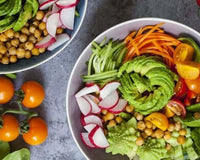
What Is GOMAD?
GOMAD stands for Gallon Of Milk A Day. That’s right. On the GOMAD diet, you will be drinking one gallon of cow’s milk per day for as long as you choose to follow it.
How To Follow The GOMAD Diet
In addition to 128 fluid ounces of milk, you are instructed to eat as you normally would on the GOMAD diet. A gallon of whole milk provides about 2,400 calories.
After a standard day of eating 2,000 - 3,000 calories combined with a gallon of milk, you will be consuming roughly 4,000 - 5,000 calories per day until you reach your desired weight.
Who Is The GOMAD Diet For?
The GOMAD diet is for people who want to gain weight fast (i.e. bodybuilders, athletes, etc.). The goal of this diet is to ensure you are consuming a caloric surplus every day. As a result, your body will be forced to store this excess energy.
While the human body can store excess energy in the form of glycogen and some added muscle, you are bound to store fat as well when consuming a high quantity of calories from dairy.
What Is Cow’s Milk And Why Do We Consume It?
This question may seem simple, yet many of us do not question our consumption of dairy products. Dairy products come in many forms: we pour it into our coffees and cereals as a liquid, we congeal it and grate it onto our pastas as cheese, we freeze it into ice cream for dessert, and we ferment it to create a variety of yogurts.
No matter what form dairy takes in our diets, a mother cow originally produces the milk that serves as the base for these products.

Just like humans, a mother cow will only produce milk once she is pregnant, as her body prepares to feed her offspring. Each nutrient in cow’s milk has been evolutionarily designed to grow a 65 pound calf into a 400+ pound cow in just one year.
Now, what happens when human beings regularly consume milk created by cows, for cows? Let’s take a closer look at the scientific literature.
Potential Benefits of the GOMAD Diet
1. Weight Gain
If your primary goal is to gain weight, this diet may help you do so, as consuming a caloric surplus will most likely result in weight gain. However, the GOMAD diet requires that you consume roughly half of your daily calories from cow’s milk.
If your goal is to bulk up and gain weight, you can consume a surplus of calories without consuming cow's milk. In fact, there are undoubtedly healthier, safer foods to help you accomplish this goal.
Potential Health Concerns Of The GOMAD Diet
1. Increased Risk Of Cancer
Nearly 40 years ago, Thomas Colin Campbell, professor of nutritional biochemistry at Cornell University, carried out a landmark study that strongly correlated dairy consumption and tumor growth in mice.
Essentially, Campbell’s researchers exposed 344 mice to aflatoxin, a substance generally recognized to promote liver cancer.
Campbell then aimed to determine if the number of precancerous cell clusters called foci could be modulated through protein intake. A high protein diet was defined as 20% of calories from protein and the low protein diet contained only 5% of calories from protein.
In this case, the researchers fed the mice casein, the main protein found in dairy products.

The above graph demonstrates the important results of Campbell’s study. The mice that consumed a high protein diet throughout the 12 weeks (represented by the blue dotted line) experienced a consistent increase in the number of precancerous cells.
However, other mice were given alternating diets from high protein to low protein every three weeks. When the mice switched from a high casein diet to the low casein diet, their early cancer cell growth nearly turned off completely.
The idea that cancer cell development can be turned on and off simply by diet alone was groundbreaking. That being said, there are clear limitations to this study. Namely, it was conducted on mice, so we cannot make assumptions about casein’s effect on the human body.
Dairy and Human Cancer
There exists a wealth of information in the scientific literature linking dairy consumption with cancer. For example, epidemiological or cohort studies allow researchers to follow a group of people over a long period of time, track their lifestyle and dietary habits, and determine their health outcomes.
In 2015, a meta-analysis of thirty-two studies found that “high intakes of dairy products, milk, low-fat milk, cheese, and total, dietary, and dairy calcium...may increase total prostate cancer risk (1)".
Calcium is an essential mineral that we all need to consume. However, that does not mean we need to consume it from dairy sources, as calcium from dairy may increase risk for prostate cancer.
Another meta-analysis of 11 scientific studies published at the University of Yamanashi in Japan found a 68% increase in prostate cancer with those who drink milk (2). Clearly, there is a strong association between drinking cow's milk and the development of prostate cancer, the most common cancer among men in the United States.
While epidemiological studies are important, experimental data is another useful tool in determining the effects of dairy consumption in humans. One such study conducted by five researchers at cancer institutes in Korea showed that prostate cancer cells displayed a proliferation of roughly 200% after exposure to casein, the main protein found in milk (3).
Whey protein, which is also derived from milk, produces a similar proliferation of prostate cancer cells in a petri dish (4).
It is also important to consider global dietary trends and how they relate to disease outcomes. Across the world, dairy consumption is significantly associated with both testicular and prostate cancer (5).


Mechanisms of Cancer Growth
After examining a small fraction of the scientific literature regarding the association of dairy and cancer, it is important to consider how dairy may contribute to the growth of cancer cells.
First, we must establish a basic understanding of how cancer develops in the body. Cancer originally begins to develop when a chemical causes a mutation to a cell’s DNA. These mutated cells clone themselves and multiply; the faster they grow and multiply, the more quickly cancer cells cluster together and spread throughout the body.
IGF-1
Cow’s milk is loaded with hormones that signal growth in a baby calf. It follows that human consumption of cow’s milk may trigger cell division in our own body as well. However, consuming milk may increase the growth rate of dangerous cancer cells in the human body.
Consumption of animal proteins such as those found in dairy tend to increase levels of the protein IGF-1 in the body, which stands for insulin like growth factor-1.
Increased levels of IGF-1 circulating in the blood are highly correlated with cancer, especially prostate cancer. A meta-analysis of 42 studies published in 2009 in the International Journal of Cancer “confirms that raised circulating lGF-I is positively associated with prostate cancer risk"(6).
However, IGF-1 is not only correlated with cancer. It plays a crucial role in the promotion and progression of every stage of cancer. It even helps our body undergo angiogenesis, the creation of new blood vessels to feed cancer cells.

So, how can we reduce our levels of IGF-1 in the body? According to a study of 292 British women, those who ate a completely plant-based diet had the lowest levels of IGF-1 in the body as compared to those who consumed dairy and other animal products (7).
Estrogen
Many cancers such as breast, ovarian, endometrial, and colorectal cancers are known to be hormone dependent cancers. In other words, hormones such as estrogen fuel the growth of these cancers. We have known for over twenty years that the main source of...estrogens (60–70%) in the human diet is milk and dairy products” (8).
In fact, after intake of cow’s milk, estrogen levels significantly increase and testosterone levels significantly decrease among men (9).

Not surprisingly, those who eat a westernized and predominantly animal-based diet have much higher concentrations of estrogen in their blood when compared to those eating traditional, plant-based diets.
Thomas Colin Campbell, the same researcher who studied the effect of casein on tumor growth in mice, later spearheaded a comprehensive study of dietary and lifestyle factors associated with disease mortality in China.
This study of 6,500 adults over 65 counties in China is known as the China Project. Compared to women in rural China, women eating a westernized diet in England had a 4x greater exposure to estrogen. In addition, they also had a 5x greater rate of estrogen-dependent breast cancer (10).

When we consume dairy and other animal products, we are directly ingesting the hormones of other animals. As a result, these hormones can affect our own hormone levels and our ability to suppress the growth of certain cancers.
OVERALL CANCER TAKEAWAY
While the mechanisms of how cancer forms are important, nutrition is best studied from a holistic perspective. The thousands of nutrients and chemicals found in food all work together in our body. For that reason, it is best to eat foods that promote health and avoid foods such as dairy that may increase the risk of disease.
Clearly, there is extensive data to support a significant correlation between dairy consumption and certain types of cancer. In the same way the human body does not require the milk of a giraffe, camel, or reindeer, it also does not require the milk of a cow.
2. Dairy Consumption May Lead To Heart Disease
According to the National Cancer Institute, dairy products account for the largest source of saturated fat in the American diet (11). Other common sources of saturated fat include:
- Animal products (eggs, meats, fish, processed meats, etc)
- Tropical oils (palm oil, coconut oil)
- Highly processed foods (cakes, pastries, fried snacks, etc.)
The most compelling data pointing to the dangers of saturated fats demonstrate a correlation between saturated fat intake and coronary heart disease, the number one cause of death in the United States.
For example, the Harvard Nurses’ Health Study researchers followed about 90,000 women over several decades. In order to examine the relationship between dairy fat intake and risk of heart disease, the researchers “adjust[ed] for smoking, physical activity, and other factors known to influence the development of heart disease” (12).
After controlling for these variables, they concluded that swapping the same number of dairy fat calories with vegetable fat or polyunsaturated fat led to a 10% and 24% decrease in cardiovascular disease. Even more impressive, swapping out the dairy fat calories with calories from whole grains lowered the risk of heart disease by 28%.

Other data confirms that saturated fats tend to increase LDL or “bad” cholesterol, which is a hallmark risk factor for coronary heart disease. For instance, a 2018 study on the effects of dietary fats on blood lipids concluded that “[compared to a meal high in unsaturated fats,] a high saturated fat meal from butter or cream seems to have worse overall effects on blood lipids” (13).
In addition, a 2017 study in the Annals of Nutrition and Metabolism found “strong evidence” that swapping saturated fats for polyunsaturated fats lowers LDL-C and the risk of heart disease (14).
If you choose to follow the GOMAD diet, the latest scientific research shows that you may be increasing your risk of heart disease in the long term. In order to protect our cardiovascular health, we ought to limit our saturated fat intake and avoid dairy products.
3. Excess Milk Intake on the GOMAD Diet May Weaken Bones
On the GOMAD diet program, you will drink one gallon of milk per day. What happens when we flood our body with milk every single day? A 2014 study followed 60,000 women and 45,000 men for 13 and 22 years respectively.
Through survey data, the researchers “found that too much milk – three or more glasses a day – was not only associated with mortality but also an increased risk of fracture and hip fracture” (15).

But, how can this be?
As Americans, nearly all of us grew up with the idea that drinking milk gives us strong bones. As it turns out, the dairy industry has carried out a fantastic advertising scheme that confirms the belief that milk is beneficial for bone health.
For example, we all remember the “Got Milk?” commercials. These advertisements were recognized by over 90% of the public when they originally aired (16). They encouraged more people to drink milk, as they portrayed it as a healthy option for athletes and health-conscious people alike.
So, this begs the question, do human beings need dairy for strong bones?
First, we must consider the history of domesticating cattle. According to a genetic study conducted in 2012, homo sapiens began consuming dairy products about 10,500 years ago (17). Clearly, our ancestors survived with strong bones for thousands of years without ever consuming dairy products.
Now, let’s fast forward to current day human beings. Roughly 65% of the global population is lactose intolerant (18). In other words, 65 out of every 100 human beings is unable to properly digest lactose, the main carbohydrate found in all dairy products.

If milk is supposed to be the magical liquid for supporting bone health, why do so many groups of people struggle to digest it? After the 3-5 age mark, we begin to lose the ability to digest lactose.
The level of the enzyme lactase, which breaks down lactose, declines quickly over time in the human body. Clearly, our bodies are not well equipped to consume cow milk products as we get older.
As stated earlier, we do need calcium to support our bones. However, calcium’s presence in cow’s milk does not justify its consumption. Other excellent sources of calcium include:
- Soy products (edemame, tofu, tempeh)
- Beans
- Nuts
- Seeds
- Leafy greens
Instead of suffering through indigestion and risking our long-term health, we can choose to consume our calcium in healthier foods. While more data is needed to determine whether dairy weakens our bones, it is evident that we do not need it to build dense, healthy bones.
Conclusions
The GOMAD diet is designed for people who want to gain weight fast. While you may accomplish this goal by drinking a gallon of milk per day, you can also safely put on weight without going to extremes.
Instead of drinking milk, which is associated with a variety of cancers, cardiovascular disease, and indigestion, you can consume a surplus of calories with a wide range of healthy foods such as whole grains, nuts, seeds, legumes, fruits, and vegetables.
If you want to drink your calories, you can make healthy smoothies with alternative milks to replace dairy!

Join the Invasion!
This Anabolic Aliens membership will grant you access to workout classes, rehab programs, diet plans, and more exclusive content to help you achieve sustainable success!










